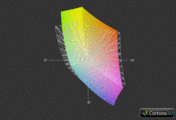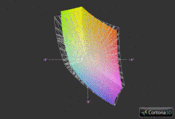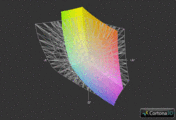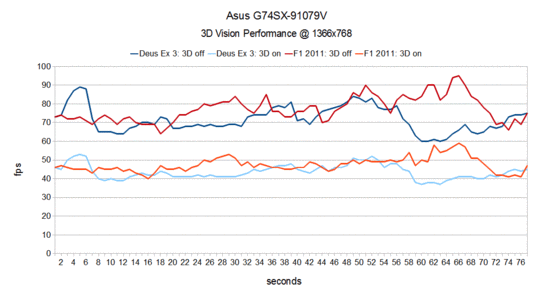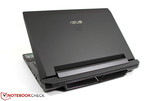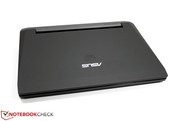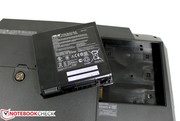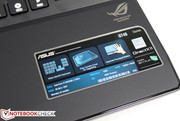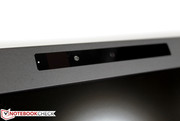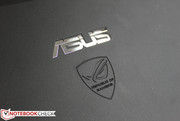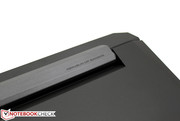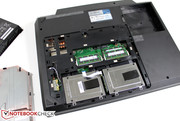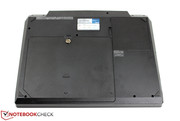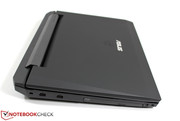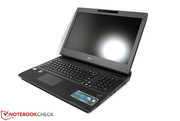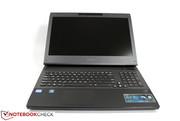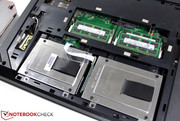Review Update Asus G74SX Notebook
With the somewhat older G73, and the brand new G74 series, Asus is teaching the gaming competition the meaning of fear. Reason: Compared to many other notebooks, the 17 inch device also scores points in areas other than pure performance. What is especially impressive is the advanced cooling system: System noise and heat emissions stay within reasonable limits. The high quality display, the impressively good manufacturing quality, and the matte insensitive surfaces, are all additional positive aspects that make the device stand out.
Enough with the pleasantries, let us take a closer look at the specifications of the reviewed device. Asus provided us with the G74SX-91079V, which is one of the most commonly sold model variants of the G74 in Germany. With the exception of the reduced RAM capacity, and a few other small details, the notebook is identical to the previously reviewed US model G74SX-3DE.
What is of little surprise is the quad-core processor from Intel: The Core i7-2630QM is very popular with users as well as manufacturers. The graphics card also belongs in the high-end segment: Nvidia's GeForce GTX 560M provides a good compromise between performance and power consumption.
In addition there are eight GBytes of RAM (2x 4096 MByte DDR3-RAM), and two hard drives with a combined abundant capacity of 1500 GBytes (2x HDDs with 750 GBytes each). Movie fans will also be pleased with the Blu-ray combo drive. The operating system Windows 7 Home Premium 64-bit is pre-installed. Asus doesn't provide premium quality cheaply: The 4.6 kilogram weighing notebook will cost buyers around 1800 Euros - a considerable sum.
Display
The display definitely belongs to the big advantages of the G74SX-91079V. Asus has equipped the notebook with a 17 inch 120 Hz capable non-glare panel, which is compatible with Nvidia's 3D-Vision technology. The package contains so called shutter glasses, which makes the three dimensional presentation of photographs, pictures, and games possible (more on this later). A Full-HD resolution of 1920x1080 is also in line with high-end expectations.
| |||||||||||||||||||||||||
Brightness Distribution: 87 %
Center on Battery: 463 cd/m²
Contrast: 691:1 (Black: 0.67 cd/m²)
64% AdobeRGB 1998 (Argyll 3D)
87.1% sRGB (Argyll 3D)
67.2% Display P3 (Argyll 3D)
Nevertheless the display doesn't only impress with its technical specifications, but also with its inner qualities. In our opinion the most respect is attributable to the exceptional brightness: An average of 431.1 cd/m² leaves the remaining competition far behind (normally about 200 cd/m²). Since the 3D operation requires a lot of light, this high level of luminance is definitely required though.
The display also scored a good to very good rating in the remaining disciplines. Thanks to the acceptable black level (0.67 cd/m²) the dark picture areas don't appear too gray, which can be especially annoying with games and movies. The contrast has an exceptionally good ratio of 691:1. Colors are relatively saturated and natural, and all sorts of media are displayed immaculately. The integrated LGD02C5 panel was also in the G74SX-3DE by the way (whereby we measured an approximately 80 cd/m² lower brightness in this case).
The viewing angle stability proves to be acceptable. Although it comes to variations on the display beyond certain angles from the bottom left and right, the images remain stable in the horizontal plane even at relatively extreme angles. Result: An external monitor can be forgone with the G74SX without qualms.
3D Vision
Nvidia is able to distance itself from the competition with its advanced 3D technology. 3D Vision is a stereoscopic process for presenting three dimensional images, while guaranteeing a flicker free operation with wide viewing angles. At the upper display edge Asus has integrated an IR transmitter directly next to the webcam, which provides for wireless connectivity with the included shutter glasses. If the 3D mode is activated the shutter glasses blend out the two halves of the displayed image so that the user experiences a 3D picture (the human vision is tricked by the slightly warped perspective of the two individual image halves).
Setting up 3D Vision is expectedly simple: Put on the activated shutter glasses and complete a configuration wizard. 3D Vision usually automatically recognizes whether or not an application is compatible after this, and responds accordingly. Practically: The configuration for the graphics card (right click desktop) allows the configuration of diverse key combination shortcuts. There is also a comprehensive compatibility list, and there are even tips for ideal configuration options provided in games.
Whether users will be content with 3D Vision over time depends on personal preference. Along with the fact that a certain portion of the population isn't even able to perceive the 3D effect, some people tend to get dizzy or feel nauseous as a result of three dimensional images. A further disadvantage is the limited comfort for people who ordinarily wear glasses. As previously mentioned the surroundings also appear significantly darker when wearing the shutter glasses with 3D activated (luckily the G74SX has a backlit keyboard).
The biggest drawback however is probably the massive performance reduction. During a short test with the racing game F1 2011, and the action game Deus Ex 3, the image rate fell by about 40% in both cases. Since the GeForce GTX 560M already encounters difficulties using the native resolution with demanding graphics settings, users will have to compromise with low or medium detail settings and a moderate resolution in many cases. In order to enjoy current games in 3D with decent quality a potent desktop system, or an SLI graphics solution in a notebook, would probably be a better option.
In brief: 3D Vision is most suitable for movies and less demanding games for mobile use. On the subject of movies: Unfortunately there is currently almost no compatible 3D material. Those that for example look for 3D Blu-rays on Amazon will hardly be overwhelmed with possibilities. For the sake of testing 3D photographs and videos Nvidia has provided the website 3dvisionlive.com.
A few more words about the accessories. Along with the 50 gram weighing shutter glasses the 3D Vision kit also contains different nose adapters, a protective bag, and a short instruction manual. The glasses are charged by an included USB cable. According to Nvidia a full charge is enough for about 40 hours of gaming use. More on 3D Vision can be found out in our special article.
Performance
The benchmarks all finished in line with our expectations. Apart from small deviations the results are similar to those of the previously tested G74SX-3DE. Let's start with the processor. Thanks to six MBytes of L3 cache, four real and four virtual cores (Hyper-Threading) the Core i7-2630QM is able to deliver a good performance. The considerably successful dual-core Core i5-2410M (Schenker XMG A501) for example only manages to score 74% less in the multi-core rendering Cinebench R10 64-bit benchmark (17013 vs 9781 points).
With single-core rendering the Core i7-2630QM also benefits from Turbo-Boost, which accelerates the processor up to a clock speed of 2.9 GHz when possible (2.0 GHz standard clock speed). 4557 points are a little more than the result from the G74SX-DE (4438 points). Users are equipped for all scenarios with the Core i7-2630QM, a potent high-end CPU developed by Intel. The successor Core i7-2670QM (see the Medion Erazer X6817) is already primed for release though.
The GPU benchmarks made the G74SX-91079V sweat a little bit more. With the Unigine Heaven benchmark (1280x1024, high, tessellation normal) the GeForce GTX 560M managed a half way smooth 27.3 fps. For comparison: Nvidia's top model, the GTX 580M was more than 60% faster with 44.3 fps (Schenker XMG P501). With the current 3DMark 11 (1280x720, performance preset) we concentrated on the GPU score. 1836 points are almost exactly identical to the result achieved with the G74SX-3DE (1834 points) US brother.
The following are a few more details about the GTX 560M. Nvidia's DirectX-11 capable high-end graphics card is based on the Fermi architecture (GF116 chip), and is equipped with 192 shaders, and GDDR5 video memory with a capacity of 3072 MBytes (192-bit interface). The clock speeds are 775 MHz (core), 1250 MHz (memory), and 1550 MHz (shaders). An automatic graphics switching solution in the form of Nvidia's Optimus has unfortunately been omitted.
The system performance is also on a good level. With PCMark Vantage the 17 inch notebook scored a respectable 8553 points. Other gaming heavyweights such as the MSI GT780R (8599 points) operate on a comparable level.
| 3DMark 03 Standard | 37816 points | |
| 3DMark 05 Standard | 21859 points | |
| 3DMark 06 Standard Score | 15327 points | |
| 3DMark Vantage P Result | 9231 points | |
| 3DMark 11 Performance | 2044 points | |
Help | ||
| PCMark Vantage Result | 8553 points | |
| PCMark 7 Score | 2490 points | |
Help | ||
Our three tested games show that not all new games can be played smoothly in the native resolution with maximum settings. While the football simulation Fifa 12 also smoothly rolls across the screen with high details and four times anti-aliasing (145.5 fps @ Full-HD), more demanding games often require a reduced configuration.
Thus the atmospheric and enthralling Deus Ex: Human Revolution became quite slow (27.4 fps) with 1920x1080 pixels, high details, MLAA, 16x AF, and DirectX-11 activated. The successful racing game F1 2011 was also less than ideal (32 fps, recommended preset 'high') with 1920x1080 pixels, ultra high details, 4x AA, and DirectX11 activated.
Altogether the GeForce GTX 560M isn't always up to the task of providing a Full-HD resolution - 1600x900 pixels would be better suited for the graphics card. Those that don't have a problem with making compromises when it comes to quality enhancements settings or reducing the resolution should find satisfaction with the GTX 560M. Hardcore gamers should however not make due with anything less potent than a Radeon HD 6990M or a GeForce GTX 580M.
| low | med. | high | ultra | |
|---|---|---|---|---|
| Deus Ex Human Revolution (2011) | 71.7 | 27.4 | ||
| F1 2011 (2011) | 76 | 32 | ||
| Fifa 12 (2011) | 218.2 | 145.5 |
Emissions
System Noise
For a gaming notebook the system noise is pleasingly quiet. Even under the maximum load the cooling fans rotate at a rather leisurely pace. The G74SX-91079V is neither clearly audible or even annoying at any time. In an idle state the system noise is also acceptable, whereby there is definitely still room for improvement in light of the heat generated. The US version G74SX-3DE led to slightly higher values in our test. Altogether even noise sensitive users have no cause for concern. Hardly any gaming notebook (especially when used for gaming) is as quiet as this.
Noise level
| Idle |
| 33.3 / 33.5 / 34.7 dB(A) |
| HDD |
| 33.4 dB(A) |
| DVD |
| 37.1 / dB(A) |
| Load |
| 35.2 / 36.4 dB(A) |
 | ||
30 dB silent 40 dB(A) audible 50 dB(A) loud |
||
min: | ||
Temperature
The case temperatures were also lower than in our previous review. An average of 24°C in an idle state, and 27°C under load, are both exceptionally good. The 'WASD hand' doesn't get uncomfortably warm after several hours either, so there is nothing standing in the way of a lengthy gaming session.
In addition to this comes a relatively low component temperature. According to the tool HWMonitor, the graphics card and processor temperatures didn't exceed 70°C during the stress test - brilliant. The only downside is that Intel's Core i7-2630QM was throttled to a mere 800 MHz clock speed under full load. This problem was already encountered with the G74SX-3DE. Although the throttling is limited to practically unlikely scenarios, Asus should make improvements in this case, especially since the cooling system should have enough free resources to provide for a normal clock speed.
(+) The maximum temperature on the upper side is 33.9 °C / 93 F, compared to the average of 40.4 °C / 105 F, ranging from 21.2 to 68.8 °C for the class Gaming.
(+) The bottom heats up to a maximum of 39.4 °C / 103 F, compared to the average of 43.3 °C / 110 F
(+) In idle usage, the average temperature for the upper side is 24.3 °C / 76 F, compared to the device average of 33.9 °C / 93 F.
(+) The palmrests and touchpad are cooler than skin temperature with a maximum of 26.2 °C / 79.2 F and are therefore cool to the touch.
(+) The average temperature of the palmrest area of similar devices was 28.9 °C / 84 F (+2.7 °C / 4.8 F).
Speakers
With the THX technology activated the audio quality is better than average. The sound makes a relatively well balanced impression, although high frequencies distort at times, and a sub-woofer certainly wouldn't have caused any harm. Without THX the sound becomes noticeably more muffled and has a reduced spectrum. The maximum volume was perceived to be decent by us. To be praised is the supported 'EAX Advanced HD 5.0'. A technology from Creative which provides for more authentic surround sound.
Battery Life
Due to the absence of a graphics switching solution the G74SX-91079V isn't exactly economical in an idle state: 26.9 - 37.0 Watts are a little less than that of the G74SX-3DE (29.8 - 41.3 Watts). Under load the power consumption quickly increases: During the 3DMark 06 benchmark, as well as during the stress test, we measured about 120 Watts (G74SX-3DE: 120.3 - 137.1 Watts). Comparable gaming notebooks, which also throttle under full load, use a lot more in some cases (for example the MSI GT780R).
| Off / Standby | |
| Idle | |
| Load |
|
Key:
min: | |
The absence of the Optimus technology takes its toll on the length of the battery life. Despite using the potent 8 cell model (74 Wh, 5200 mAh), the notebook has to be charged again relatively quickly. During the Classic Test from Battery Eater (high load) the 17 inch notebook lasted a mere 53 minutes with maximum brightness and deactivated power saving options. At least when opting for maximum power savings and minimum brightness it is possible to keep the notebook powered for up to three hours in idle operation (Readers Test from Battery Eater).
Verdict
The G74SX-91079V confirms the impressions of the previous review. Compared to other gaming notebooks the list of positive aspects is relatively long. Starting with the 120 Hz capable Full-HD display, which appeals with an exceptionally high brightness, a matte surface, and 3D support.
The impeccably manufactured and insensitive case also impressed us (with the exception of its size and weight). The rubber surfaces are very pleasant and also stay surprisingly cool under load. Other positive aspects include the moderate system noise, the white keyboard backlight, the integrated Blu-ray drive, and the relatively good audio quality. With some small exceptions the input devices are also a success. The performance is essentially very good thanks to the quad-core processor and the high-end graphics card, although proper 3D gaming would ideally require more graphics power.
One of the negative aspects is the limited selection of interfaces. For a price of around 1800 Euros, buyers could definitely expect an ExpressCard slot, a FireWire and eSATA port, and two USB 3.0 ports. Aside from this the excessive installation of software, and the limited battery life (no Optimus) also don't live up to expectations.
Altogether Asus provides a powerful, high quality, and thoroughly thought through gaming notebook, which belongs among the absolute elite along with its Alienware counterparts.





